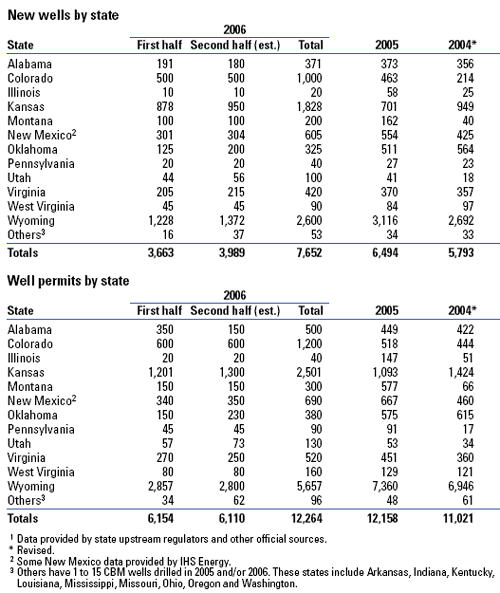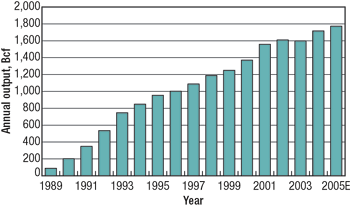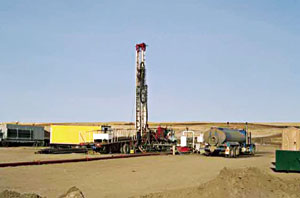Unconventional Resources
Coalbed methane activity expands further in North America
CBM production and reserves growth is slower, but drilling remains frenetic.
Kurt S. Abraham, Managing/ International Editor
Although growth in North American coalbed methane (CBM) activity slowed during the last 12 months, it has still been a strong period for this subset of the E&P industry. Estimates of global in-situ CBM reserves now range between 3,500 and 7,500 Tcf, and the North American figure is between 1,000 and 3,000 Tcf. Within the North American number, the US figure most often cited is 700 Tcf.
Actual CBM reserves that are technically recoverable are much lower. In the US, various numbers have been tossed around, with one estimate of 243 Tcf from five western US basins. However, the US Department of Energy (DOE) has adopted a 100-Tcf figure in its discussions. Furthermore, the US Geological Survey last November issued a “mean case” estimate of technically recoverable US CBM reserves of 67 Tcf. Of that amount, 24.24 Tcf are in the San Juan basin, 14.26 are in the Powder River basin, and 8.4 Tcf in the Appalachian basin. DOE’s latest estimate of proved CBM reserves covers 2004, when the US figure totaled 18.39 Tcf. Given a high level of drilling, 2005’s number may reach or exceed 2003’s level of 18.74 Tcf.
The Canadian Gas Potential Committee (CGPC) has estimated Canada’s in-place CBM reserves at 528 Tcf. Of that number, about 218 Tcf are in the nation’s primary CBM basin, Horseshoe Canyon, and another 239 Tcf are in the Mannville coals. During the last year, CGPC has gone further and estimated “nominally marketable” CBM reserves at between 11 and 46 Tcf. This estimate excludes in-situ resources deeper than 4,000 ft.
US CBM activity. As was the case 12 months ago, CBM statistics for reserves, production and drilling are hard to pin down. Many of the problems reported in tracking CBM activity remain the same. These include interaction of conventional gas wells with CBM wells, including conversion of some of the former to the latter. There are also inconsistent state agency permitting and reporting procedures for CBM wells (a few states do not work very hard at breaking out the CBM figures from overall data), as well as increasing time lags in reporting and wildly inconsistent reserve estimations.
As reported to World Oil by state agencies and tallied in Table 1, there were 6,494 CBM wells drilled during 2005, up 12% from 2004’s figure. The 2004 number has been revised upward by 436 wells as new, more complete data have trickled in from several states. This year, a nearly 18% jump in CBM drilling is forecast to 7,652 wells, with more than 3,600 wells already spudded in the first half. Furthermore, permitting will remain at a high level, with 12,264 permits expected this year for a 1% increase. The leading state for CBM drilling remains Wyoming, followed by Kansas and Colorado. About 60% of all US CBM wells are drilled to a depth of 1,100 ft or less. Typical half-life of a well is 13 years.
| TABLE 1. US coalbed methane wells/permits1 |
 |
|
As shown in Fig. 1, the US Energy Information Administration (EIA) said that CBM production took a 7.5% jump to 1.72 Tcf in 2004, after declining slightly in 2003. Although EIA has yet to report a 2005 figure, World Oil is estimating last year’s output at about 1.78 Tcf, or a 3.5% increase.
 |
Fig. 1. US coalbed methane production.
|
|
 |
Fig. 2. A typical CBM drilling site in Alberta’s Horseshoe Canyon. Photo courtesy of Alberta Geological Survey.
|
|
The leading US CBM producing region is the San Juan basin of Colorado and New Mexico. Together, these states contribute about 60% of all US CBM output, which EIA said was 2.87 Bcfgd in 2004, and which likely climbed above 2.9 Bcfgd in 2005. EIA’s 2004 proved reserve figure for the two states was 10.95 Tcf.
The next largest CBM production area is the Powder River basin, where Wyoming and Montana produced CBM a combined rate of just over 900 MMcfgd in 2004, a figure that increased to nearly 1.0 Bcfgd in 2005. EIA’s 2004 proved reserve figure for these two states, together, was roughly 2.4 Tcf. There is an estimate that more than 32,000 CBM wells are now producing in the Powder River basin.
CBM development continues to pose environmental and operational issues in the US. These include disposal of water removed from wells as part of the dewatering/ production process; a drop in drinking water levels near CBM fields; potential contamination of aquifers; venting and seeping of methane and other chemicals into fields, forests and rivers; occasional underground fires, similar to those that plague coal mining areas; and disputes about air pollution.
One environmental solution, funded by National Energy Technology Laboratory and developed by Drake Engineering of Helena, Montana, helps CBM operators clean up co-produced water. Drake’s process grew out of a project in which researchers at Montana State University evaluated phytoremediation of CBM-produced water. Through a project subcontract, Drake researchers developed a prototype of a lab-tested, fluid-bed resin exchange treatment system for removing sodium from CBM-produced water. Drake has since patented and begun commercializing the process by field-testing it in Powder River operations.
In another project, DOE is funding a San Juan basin pilot test that will examine Enhanced CBM efficacy with 75,000 t of injected CO2. There will also be an Enhanced CBM terrestrial pilot test. Because ECBM operations are known for producing large volumes of salt water, the project will desalinate produced water from the pilot and use it to irrigate a riparian restoration project near Navajo, New Mexico.
Canadian CBM. The nation’s focus on CBM activity is in the Western Canadian Sedimentary basin, primarily in Alberta, with additional potential in British Columbia.
In Alberta, CBM reserves jumped 181% to 740.7 Bcf (20.9 Bcm) at the end of 2005, compared to 263.4 Bcf (7l.42 Bcm) at the end of 2004. As of late last year, Canadian investment in CBM had gone beyond $1 billion, with roughly 3,900 wells drilled and completed. Of that number, 3,189 were connected for production. Many of the well connections are in central Alberta (PSAC Area 5) and southeastern Alberta (PSAC Area 3), representing 47% and 43% of all wells connected in 2005, respectively.
EUB also reported that 1,649 CBM wells were drilled during 2005, compared to 1,174 wells in 2004. The number of new well connections rose from 1,205 in 2004 to nearly 2,000 last year. Perhaps well over 3,000 CBM wells will be drilled this year, and there have been some wild estimates of 4,000. Alberta’s CBM production totaled 102.92 Bcf (2.9 Bcm) in 2005, equal to 281.98 MMcfd and up 383% from the minor level achieved in 2004. During that year, output was only 21.29 Bcf (0.6 Bcm), or 58.2 MMcfgd.
Until last year, virtually all of the CBM output came from Horseshoe Canyon of southeastern and central Alberta. However, a Nexen-Trident Exploration JV has invested C$100 million to test production from the Mannville coals, which are much more difficult, due to copious volumes of saline water. According to Nexen, the JV has succeeded largely because of horizontal drilling. Elaborating on the progress made, Trident CEO Jon Baker has told various media outlets that the first commercially economic results at Manville are within reach. Nexen said it has eight rigs drilling, and construction of 94-MMcfd gas processing facilities has been completed. Output at mid-2006 was 5 MMcfgd, and that figure should rise to 30 MMcfgd by year’s end. Through additional drilling and facilities construction, the firms expect to add another 150 MMcfgd by 2011. According to a report by PLS, Inc., Canaccord Capital has calculated that drilling, completing and tying in a Mannville well costs C$750,000 to C$1.5 million versus C$300,000 for a Horseshoe Canyon well.
In British Columbia, authorities estimate the CBM potential at up to 90 Tcf. Marketable volume estimates range from 18 to 50 Tcf. Although no commercial production exists, officials approved 18 exploratory CBM wells in 2004. A similar number were due to be drilled last year and into 2006. 
|





